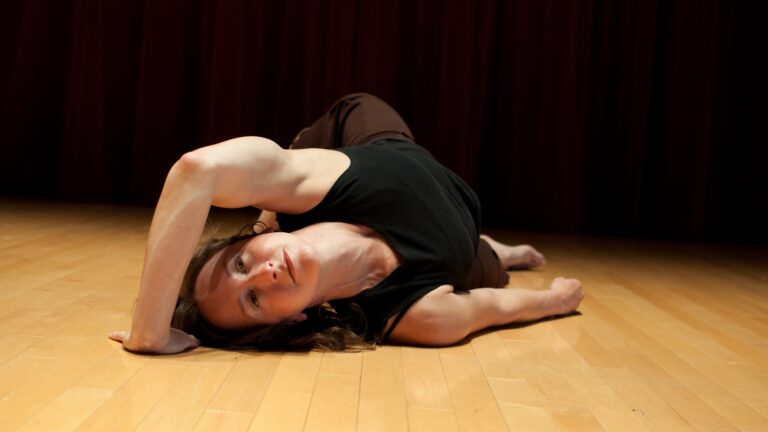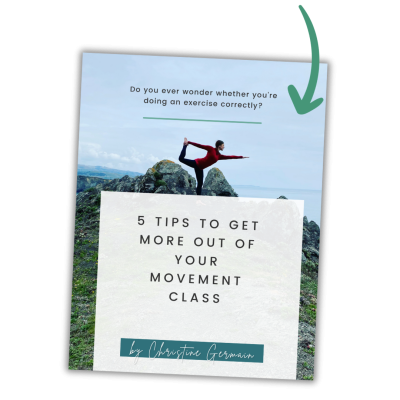Embodying choices

I grew up not having many tools to explore my choices. Things were either good or bad, right or wrong, and I wasn’t aware of all the options available in between, resulting in a lack of freedom. Don’t get me wrong—I was free and expressive and privileged. But in my youth, I didn’t have many tools to temperate myself. I was going all out, giving my 100%, and driving myself empty, until I no longer had a choice, other than to rest. Then I would go full out again.
I’ve been studying various qualities and intensities in movement and dance for as long as I can remember. When I started studying the Feldenkrais Method®, it changed how I see the world; it opened me up to more choices and more freedom, not only physically, but mentally as well.
Whether I teach Pilates, Feldenkrais®, dance, or anything really, I always invite students to bring inquiry into what they are doing, and encourage them to explore more choices. That way, they feel more involved in their transformational process (whether it be rehab, self-image, behavior, or posture), and they become more in charge of their own wellness.
The Rule of Three:
During “Awareness Through Movement®” Classes, we often suggest that you try three different variations in positions or movement. For example, if you’re lying on your back and I ask you to bend your knees with your feet on the floor, is the place where you chose to place your feet first the most potent and comfortable position? Very often, people don’t question that simple position, and actually waste energy by having to work harder than needed, just to keep their legs that way.
Why is that simple detail important? Because that’s how so many of us go through life. Many of us get settled in our habits without questioning, and there is a waste of energy that could have possibly been used in a more efficient way. Though I trust that every individual does the very best they can with what they know, we don’t always know enough. So, a good principle is to try three different variations in things we do, even with the things we don’t think need refinement. There is always room for improvement.
So I invite you, the next time you do an habitual action (such as bending your knees when you’re on your back, or sitting in front of your computer) try three very small variations. First, register what your initial choice was. Then, introduce two other choices. For example, feet close together, and feet further apart. What feels better to you? Not because someone said so, or because you think that’s how it should be, but because you tuned in to your own needs—your own kinesthetic sense. Trust the intelligence of your nervous system. This whole process encourages curiosity and inquiry, so that you can get a sense of what’s familiar, and then consider other options, before you pick your favorite.
Is it comfortable because it’s familiar, or because it’s more efficient?
If you only have two choices, it’s hard to know if the one that feels more comfortable is just because it’s familiar, or if it is actually the most potent choice. And if you can only choose between A and B, it seems like everything that is A is not B, and everything that is B is not A. It can easily be interpreted as right or wrong. However, when you add a third choice, it could feel less like being stuck in between one side or the other. Instead, this practice of noticing a range of options encourages curiosity, and to push beyond good or bad. Things, humanity, and nature are way more complex than being binarily simplified. This process invites us to think more critically, and be more engaged in the array of intentional choices that we can make.
Human nature (evolutionary wise) is to try to save energy, move efficiently, and protect itself from injury or pain. Sticking to what’s familiar and/or what has worked before, is one way of doing this, but can sometimes establish detrimental habits or patterns through repetition; there is risk of stagnation and limiting new discoveries. If I can get my goal-oriented achiever self to listen to what is needed in that moment, rather than making immediate assumptions, will I be able to connect throughout my whole system? We are creatures of habits, but are the current habits still serving us? The mere act of observing and paying attention can incite change. Our behaviour and movement adapt to whatever we are paying attention to. Therefore, consciousness/awareness is an act of transformation. This perspective made me realize how there isn’t just one choice, or the other, but a spectrum of many options. Recognizing how many options there are allows for more freedom of choice.
So next time you sit at the dinner table, try three small adjustments, just by slightly shifting your weight a bit more to the left or the right, forward or back, and appreciate that you have the potential/power within yourself to explore more choices. There is freedom in how you choose to take action—in the intensity of effort, the speed, and so on. You can make choices on how you react to the world around you.
Over the holidays, I know I can’t decide how others will behave or project their ideas, but I am practicing how I can make more choices available to me in my movement, so that I can avoid having a compulsive response. Could I learn through a movement to be a better citizen, who is more curious and who flows more gracefully in and out of difficult conversations? Can I move beyond rage and explosive reactions, and proceed into an inquiry of how the reaction affects the way I sit or breathe? Perhaps this work is intimidating, as we claim responsibility for our own well-being, by having the agency of making choices. Sometimes such responsibility appears too big, but can be empowering when we realize the door to a better future is in our hands—at least for the things we can control.
Thank you for taking the time to read my thoughts!
Healthy Wishes for Your Body and Mind,
Christine
Photo Credits: Oda Aase Johnsen


